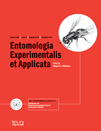Ver ítem
- xmlui.general.dspace_homeCentros Regionales y EEAsCentro Regional Buenos Aires NorteEEA Delta del ParanáArtículos científicosxmlui.ArtifactBrowser.ItemViewer.trail
- Inicio
- Centros Regionales y EEAs
- Centro Regional Buenos Aires Norte
- EEA Delta del Paraná
- Artículos científicos
- Ver ítem
Plant‐based compounds with potential as push‐pull stimuli to manage behavior of leaf‐cutting ants
Resumen
Leaf‐cutting ants are a serious pest of young forestry plantations. Currently, the main control method is the use of broad‐spectrum insecticides, which have a negative effect on non‐target organisms and the environment. In this work, plant‐based compounds were evaluated in laboratory assays with Acromyrmex ambiguus Emery (Hymenoptera: Formicidae) for their potential use as repellent and attractant stimuli to be used in a push‐pull strategy. Farnesol, a
[ver mas...]
Leaf‐cutting ants are a serious pest of young forestry plantations. Currently, the main control method is the use of broad‐spectrum insecticides, which have a negative effect on non‐target organisms and the environment. In this work, plant‐based compounds were evaluated in laboratory assays with Acromyrmex ambiguus Emery (Hymenoptera: Formicidae) for their potential use as repellent and attractant stimuli to be used in a push‐pull strategy. Farnesol, a sesquiterpene present in many essential oils, was tested as a repellent at doses of 10, 50, and 100 mg. Its distance of action was studied by comparing the repellent effect of farnesol in a situation in which ants had to touch the farnesol in order to reach the food source in comparison to when ants could reach the food source without getting into direct contact with it. Different parts of the orange fruit (pulp and peel) were evaluated and compared as attractants, given that citrus‐based baits are among the most popular attractants used. Results from laboratory bioassays indicated that farnesol is repellent at doses of 50 mg and acts upon contact or at a very short distance. Furthermore, orange pulp was more attractive than the peel, and volatile compounds were highly responsible for the attraction. When both stimuli were tested simultaneously in a laboratory experiment, repellency of farnesol was enhanced in the presence of orange pulp odor. When tested in a field push‐pull experiment, the results also showed a good repellent effect of farnesol as well as an attractant effect of the orange pulp. These results encourage long‐term studies with these substances in a field setting and suggest that repellents can be enhanced by the use of attractants to manage leaf‐cutting ants behavior.
[Cerrar]

Autor
Perri, Daiana;
Gorosito, Norma;
Fernandez, Patricia;
Buteler, Micaela;
Fuente
Entomologia Experimentalis et Applicata 163 (2) : 150-159 (May 2017)
Fecha
2017-05
ISSN
0013-8703
1570-7458
1570-7458
Formato
pdf
Tipo de documento
artículo
Palabras Claves
Derechos de acceso
Restringido
 Excepto donde se diga explicitamente, este item se publica bajo la siguiente descripción: Creative Commons Attribution-NonCommercial-ShareAlike 2.5 Unported (CC BY-NC-SA 2.5)
Excepto donde se diga explicitamente, este item se publica bajo la siguiente descripción: Creative Commons Attribution-NonCommercial-ShareAlike 2.5 Unported (CC BY-NC-SA 2.5)

